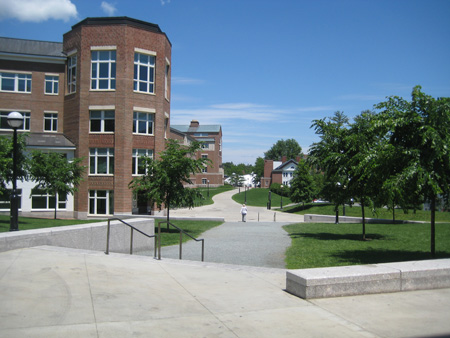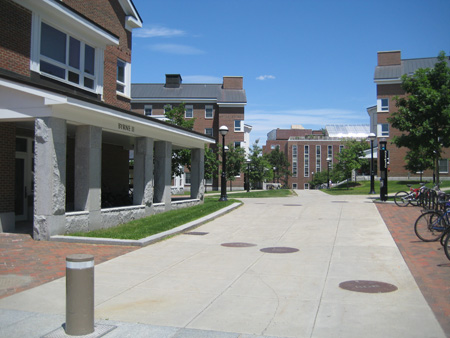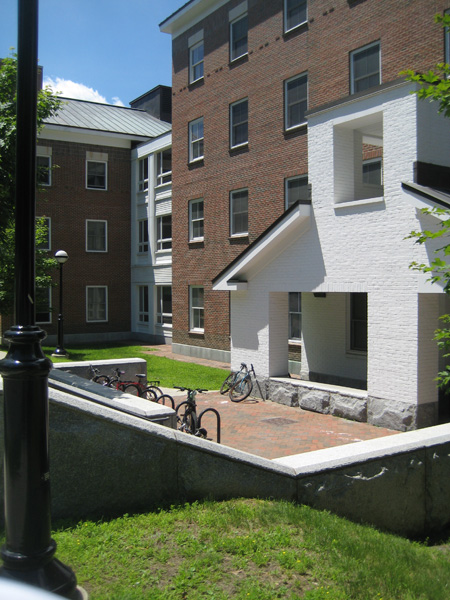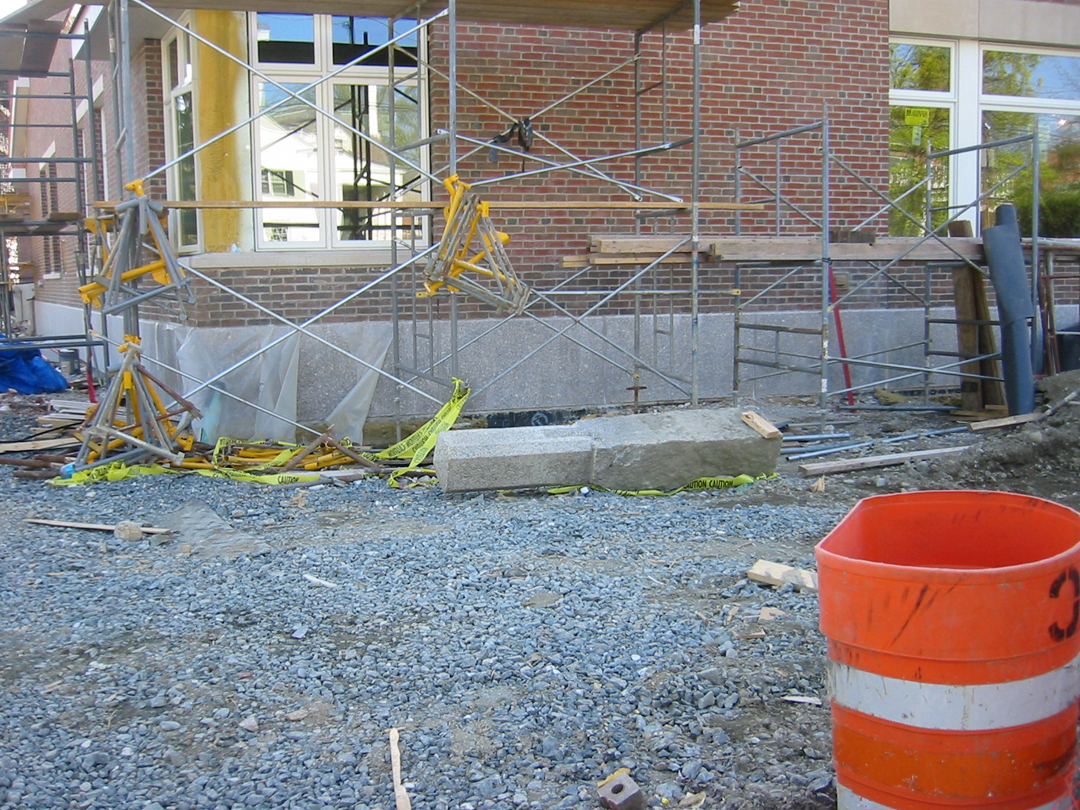-
Fascinating and unexpected historic New Hampshire mica mine for sale: Eagle Tribune.
-
Bora (formerly Boora) Architects have put up a couple new images and larger versions of their old ones for the Hopkins Center expansion. The new porte-cochere, which would tear down Harrison’s stone wall and put up a transparent box with a glass “curtain” wall, is striking for the literalism of its opening-up of the Hop. The new reference to the project as “unbuilt” is troubling.
-
The Valley News reports on a Cambodian food truck that serves Hanover.
-
Big Green Alert reports on the plaque honoring Kathy Slattery Phillips in the new press box at Memorial Field.
-
Dartmouth Now reports that the board of trustees, at its Commencement meeting,
affirmed plans to proceed with the renovation and expansion of the Hood Museum of Art. The trustees also voted to approve $10 million for construction of the Moosilauke Ravine Lodge and $22 million to build a new indoor athletics practice facility. Each of these projects will be funded through private gifts to Dartmouth.
-
One of the goals of the current Thayer School fundraising campaign (Dartmouth Now):
Construct a 180,000-square-foot building, which will nearly double the school’s total floor space. The building, to be located directly south of the MacLean Engineering Sciences Center, will provide more space for classroom teaching and experiential learning, with an emphasis on Thayer’s growing efforts in design and research priorities in energy technology and engineering-in-medicine.
-
The Town of Orford celebrated the 250th anniversary of its founding with a reading of its charter on the East Common (Here in Hanover).
-
The Rauner Library Blog reports on a time capsule from 1977 that contained a can of Miller High Life. The can was kept in the archives but had to be drained recently.
-
Thanks to the U.Va. School of Architecture for including the Campus Guide in its 2016 Alumni Exhibit, on university living-learning environments.
-
The Valley News has a story on the Hartford Christian Camp. It sounds like a lovely place, and the kind of summertime experience that was common a century ago. In Charlottesville, Virginia, a similar camp has been incorporated into the city and its surviving cottages have become year-round houses:
-
U.Va. has a collection of campus then/now photos.
-
The Dartmouth has an article on the school’s architecture studio.
-
Big Green Alert reports on the new FieldTurf at Memorial Field.
-
Volunteers in Meriden are digitizing the E.H. Baynes slide archive, the Valley News reports. Baynes was the conservationist and traveling lecturer who, at a talk in Webster Hall during the early 1900s, suggested that Dartmouth students raise money to save the bison and adopt the animal as their mascot.
-
Green Building Advisor has a detailed look at the construction of the four new modular houses being installed for faculty as part of the “house communities” plan. The school has a video update on the construction. Big Green Alert has earlier and later photos of the tensile “community” building that now stands by Davis Varsity House.
-
It is common these days for sportswear companies to design team uniforms, logos, and mascots. For the British team at the 2016 Olympics, Adidas worked with both the College of Arms (England) and the Lord Lyon King of Arms (Scotland) to create a coat of arms that would be conferred by a dual grant (College of Arms news).
Category Archives: Kemeny/Haldeman
Museum-like displays; a Hanover designer
The old idea of the trophy room for intercollegiate athletics seems to be shifting toward something closer to a museum, with text and graphics (reproductions of historic images, not originals) arranged to tell a story. Objects are displayed in support of the story rather than as the spoils of victory.
The Friends of Dartmouth Football Timeline, Video Archive Kiosk and Memorabilia Exhibit at Floren Varsity House is an example. Designed by the Hanover firm of Charles Gibson Design, the comprehensive display is the closest thing Dartmouth has to a permanent museum of any aspect of its own history. (I do not know what proportion of the old trophies are kept in Floren, in Davis Varsity House, or in the Oberlander Lounge in Alumni Gym.) Gibson also designed a timeline for hockey in two locations in Thompson Arena and a display recognizing donors John and Carla Manley.
During the Seventies and Eighties, Charles Gibson worked in the Hop’s Graphic Design Studio, and since then his firm has done a lot of work for the college and other area institutions. The firm revised the campus map (the next-to-latest iteration); created signage (including the mainframe-like kiosk that occupied the entrance of the old Kiewit); and paper plates and cups for the Courtyard Cafe in the Hop. The Nugget Theater’s freestanding marquee, influenced by the Classical porticos of Main Street, is another product. (By the way, doesn’t the little photo of the modest portico of the Hanover Post Office make that building look like a Great Work of Architecture?)
Most notably for our purposes, Charles Gibson Design did a Comprehensive Identity Program for Cardigan Mountain School, including a revision of the school’s seal that features a green shield containing a lone pine and open book. And if you are thinking about the “Dartmouth base,” the wavy lines of water in the base of the shield of each of Dartmouth’s schools, Gibson did a logo for the local school district in conjunction with the Banwell addition to Hanover High. For the country’s first interstate school district, drawing from both Hanover and Norwich, the circular logo presents the Ledyard Bridge above wavy water lines on a green field.
Observing Berry Row
I. A recent one-paragraph review.
One alum quoted in the Alumni Council’s annual report (pdf) stated:
The north campus is appalling. The buildings look like something from USC and it is barren of trees. Further, the buildings pointlessly drift off to the right, making it an unsatisfying prospect. Seriously, from Berry north they need to plant several thousand trees to soften and obscure this severe, inappropriate landscape.
There is something worth discussing here. The unusual wording itself creates a number of questions:
-
What does “north campus” mean? Is it the area around Kemeny, the stretch from Berry to Moore, or the stretch all the way up to Gilman? The word “severe” in reference to the landscape suggests that he* is referring to the Kemeny area, which has low granite walls. But who knows?
-
How quickly are trees supposed to grow? Berry Row was recently a construction site. One supposes the same trees are to a) provide general natural beauty (“The north campus is barren of trees”) and b) obscure a landscape.
-
The buildings drift “pointlessly” to the right: does this mean that the buildings fail to lead to a point, such as the still-unbuilt terminus of the Berry Row axis, or does it mean that the alignment of the row should follow an unbending north-south line no matter what goes on in the surrounding streets? It is obvious that the curve in the line of buildings traces of the historic curve in the town’s street grid, which in turn follows the bend in the river.
-
Is the USC comparison useful? The rather attractive buildings of USC do not look similar to the buildings of Berry Row and do not seem to have been designed by Moore’s firm, unlike, say, certain buildings of UCLA, UCSB (Kresge College, 1971), UCSC, and Berkeley (Haas School of Business, 1995).
II. Another take.
Kemeny/Haldeman seems successful. The building’s street facade is admirably modest in scale; the twin porticos are delightful. The way the building works with Sherman to bracket Carson Hall is important and it seems well done. The towers on the inside of the block are not as notable as they could be and disappoint somewhat. The handling of the termination of the main tower’s north facade might be a mistake: it is not much of a tower if it does not even meet the ridge of the roof.

The eccentric footprint of the McLaughlin Cluster has the potential to be too quirky for its own good, but it works; the apparently arbitrary inflection is not bothersome.

A brochure-quality view of McLaughlin captured by Google Street View looks to the south toward the towers of Sudikoff and Baker. The use of granite and white-painted brick, reminiscent of Dartmouth Hall, is appealing.

Street View has a photo of the hefty sculptural light-pier at Bildner’s front entrance.
The absence of shutters on McLaughlin is a bit of a let-down, but shutters seem to be the litmus test for traditionalism in Dartmouth buildings these days: Fahey-McLane was meant to be shutterless but got them anyway, according to one account, because they were important to a donor.
—————–
* Really a “he”? He seems to be under 40 (the youthful use of “seriously”) but might view himself as having the tastes of someone over 60 (the use of the antiquated “prospect” instead of “view”).
—–
[Update 11.17.2012: Broken link to Alumni Council pdf fixed.]
Buildings – construction, some demolition
Rauner Library has provided a remarkable photo of the Butterfield Museum embraced in a death-hug by Baker Library. This is a view of the south and east facades of the east wing of Baker, looking to the northwest. The problem of Butterfield appears to have had a significant influence on the design of Baker.
See also the photos of the bells and the steel frame of the tower under construction.
With historic Clement Hall demolished (film and photos), the Visual Arts Center construction has been put out for bid.
Phi Delt reconstruction continues, The Dartmouth reports.
Engleberth Construction provides photos of the Tuck Living-Learning Center (Achtmeyer, Raether, and Pineau-Valencienne Halls).
It is not new, but Forever New: A 10-Year Report provides a comprehensive photo of the interior-block facades of Kemeny-Haldeman not available elsewhere.
Some views of recent construction
A remote tour of recent construction via Google Street View images made around August 4, 2009, judging from the Hop’s marquee:
- The north end addition to Theta Delta Chi (view to southeast);
- The east end addition to Gile and rear addition to Hitchcock (view to north showing Gile getting a new copper roof);
- Fahey Hall (view with Butterfield);
- The redone Tuck Drive/Tuck Mall intersection (view to north; the Google Maps aerial is older and shows Fahey-McLane under construction);
- The stair addition to the west end of Bones Gate (view to south showing unobtrusive one-bay addition);
- The Zeta Psi addition (view to south showing front of building with addition under construction);
- The Chi Gamma Epsilon fire stair (view to north showing roofed but unenclosed fire escape — wonder why other houses didn’t do this if they could get away with it);
- Kemeny-Haldeman (view to east; Carson terminates Webster Avenue and is framed by Haldeman and Carpenter);
- The addition to Tabard (view to south showing rear of building; the Google driver went down this unnamed alley by the Choates before thinking better of it);
- The addition to Phi Delta Alpha (view to south showing rear of interesting, almost agricultural addition);
- The new Phi Tau (view to southeast showing side; the end view to the north shows the building’s interesting proportions);
- Berry Row (view “down” to the south);
- The McLaughlin Cluster (view of “outside” to the northeast; views “down” to southwest and “up” to northeast).
- The New Hampshire Hall additions (view to southwest showing east end addition); and
- “Whittemore Green” behind Thayer School (views of landscape including flowers and curving paths; hmmm).
Berry Row construction continues
The Shower Towers are almost gone
The OPDC continues its generous photographic documentation of the Bradley/Gerry demolition: one view shows Kemeny with Berry in the background, as it was meant to be seen, although just a little bit of Bradley is still standing.
Calling it “Berry Row”
The campus urban space north of Berry Library does not seem to have an official name yet. Although it is smaller and less formally designed than the Green or Tuck Mall, it is analogous to those two spaces in the way it extends from Baker Library, and Dartmouth is about to give its landscape an ambitious redesign by Richard Burck Associates. The space needs an official name.
Here’s hoping it gets called Berry Row, a name that several people have suggested already.* The name is conservative, and it makes sense: the three buildings that will line the west side of the space (Kemeny Hall, some future building, and Moore Hall) are analogous to the three-part Dartmouth Row and its progeny, Fayerweather Row and Massachusetts Row. Each of those rows creates a public space in front of it that may also be known by the name of the row.
Particular sites within the space still may have their own names, such as the proposed Alumni Plaza (nixed in 2007 Class Treasurers Meeting pdf).
*”Berry Row” was big in 1998:
- [William D. Brawley?], Interface 29:2 (Winter 1998), 10 (pdf).
- Alex Shartsis, “New Math Building Will Honor Kemeny,” The Dartmouth (22 July 1998).
- William D. Brawley, “For Some People, It’s Becoming Increasingly Difficult to Tell Where Traditional Libraries Stop and Traditional Computing Services Begin,” Dartmouth College Library Bulletin (November 1998).
—–
[Update 11.12.2012: Broken link to 2006 Class Treasurers Report replaced with link to 2007 report.]
[Update 08.31.2013: Broken link to 2007 report pdf removed.]
Kemeny/Haldeman brick pattern explained
The Kemeny/Haldeman project page notes that the patterns in the building’s decorative brick display a Fibonacci sequence (0, 1, 1, 2, 3, 5, 8, etc.). The pattern comprises a field of soldier-course bricks from which certain bricks protrude.
The Math Department’s previous headquarters, Bradley Hall (connected to Gerry Hall as the “Shower Towers”), was known to display some pattern in the arrangement of its blue, green, and white tiles, although what it represented did not seem to be commonly known.
[Update 12.31.2006: information on pattern added.]
Berry Row’s south end taking shape
The creation of Berry Row as a campus space is making progress as the landscaping for Kemeny/Haldeman, designed by Richard Burck Associates, gets underway.
Various building topics
The Dartmouth and Vox have covered a number of building-related topics recently:
- Zoning for the 53 Commons north of Maynard Street
- The dedication of Kemeny Hall and the Haldeman Centers on the Kiewit site
- The Real Estate Office, which is redeveloping the block south of the Hop
- The Faheys’ gifts
- The Records Management office, which has moved out of Centerra to Etna Road in Lebanon:

—–
[Update 11.10.2012: Broken link to Records Management fixed.]
More preservation in the computer age
Google’s recent acquisition of the garage where it began as a company in 1998 and the preservation of the garage where Hewlett and Packard began working in 1938 point out the importance of documenting Bradley and Gerry Halls and marking their sites after they are demolished, since they have some role in the history of computing. Demolition begins as soon as this month.
Bradley is not, however, the place where Kemeny and Kurtz and others created BASIC in 1964, as reported here in “A Plea for the Shower Towers.” A College news release states that BASIC was invented in College Hall, and that is indeed where the school put its GE-235 during February of 1964 after taking delivery of it. BASIC first ran that May and the school moved the machines to the existing Bradley Hall later.
E.K. Smith’s post is down but survives
The possibly-1860s granite post mentioned earlier as surviving the Kemeny Hall construction has been pulled, but the fact that it remains at the construction site encourages the speculation that it will be replaced when the building is finished:
The granite post on North Main
A granite post on North Main Street (visible to the left of the pickup in a Math Department photo) has been left up during the construction of the latest building adjacent to it, Kemeny Hall. The post appears to be the last surviving element of confectioner E.K. Smith’s 1868 house.
[Update 12.31.2006: construction photos showed the post lifted out of the ground, and photos of the completed Kemeny Hall do not show it.]
Planning office renamed
- It seems that the the Facilities Planning Office (previously the Office of Facilities Planning?) has become the Office of Planning, Design, and Construction (see the website of September 2004, showing old name while accessing current images; the name of the site directory is still “~fpo”).
The new name is clearer and more informative, but nothing beats the style of the design office that is associated with the Capitol in Washington: The Architect of the Capitol.
- The walls are up in the McLaughlin Cluster (webcam looking south from Gilman), being built by Engelberth
- Kemeny/Haldeman is in its yellow stage and the steel framing for the tower (no name apparently announced yet) is up (photos from the Math Department project site).
- The Dartmouth has more on Fred Wilson’s exhibition in the Hood and about the Hood.
- Skypic has available aerial views (1 | 2) of Dartmouth.
Kemeny/Haldeman topped off
Buzzflood points to a Vox article noting that Kemeny/Haldeman was topped off Friday, July 15. The Math Department has photos of the tree and flag atop the building’s yet-unnamed tower.
Construction boom
The Valley News reports on the largest construction boom in recent memory, with $180 million in College and Town projects underway.
Kemeny/Haldeman naming
Nearly two thousand people donated a total of $10.7 million to win a $1 million challenge grant from the Kresge Foundation toward the construction of Kemeny/Haldeman, the school has announced.
For $5 million, you may still name the building’s tower, depicted at right in a rendering of the building. A special floor plan (1.5mb pdf) designates some of the building’s other nameable features.
